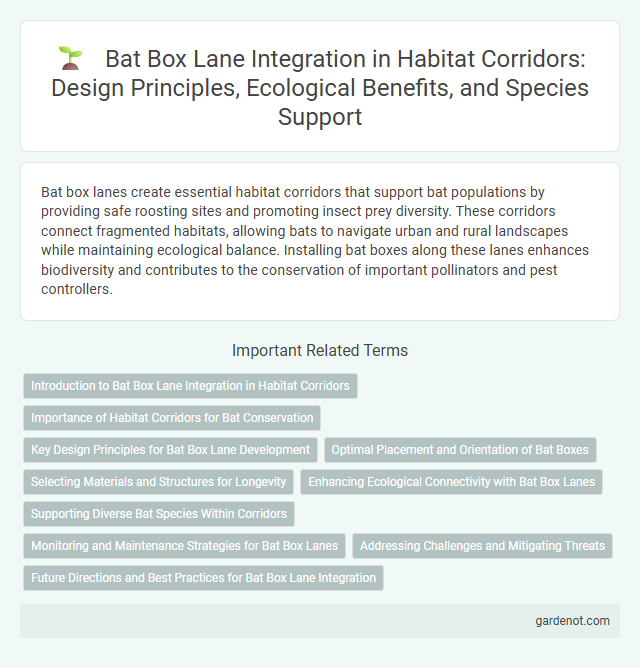Bat box lanes create essential habitat corridors that support bat populations by providing safe roosting sites and promoting insect prey diversity. These corridors connect fragmented habitats, allowing bats to navigate urban and rural landscapes while maintaining ecological balance. Installing bat boxes along these lanes enhances biodiversity and contributes to the conservation of important pollinators and pest controllers.
Introduction to Bat Box Lane Integration in Habitat Corridors
Bat Box Lane serves as a vital component in habitat corridors by providing essential roosting sites that enhance bat population connectivity across fragmented landscapes. Integrating Bat Box Lane into habitat corridors supports biodiversity by facilitating safe movement and genetic exchange among bat colonies. The strategic placement of bat boxes within these corridors promotes ecosystem stability and mitigates habitat loss impacts.
Importance of Habitat Corridors for Bat Conservation
Bat box lanes serve as vital habitat corridors that facilitate safe movement and foraging for bat populations, enhancing biodiversity in fragmented landscapes. These corridors connect roosting sites and feeding areas, reducing habitat isolation and promoting genetic diversity among bat species. Effective bat conservation relies on maintaining and restoring such habitat corridors to support sustainable bat populations and ecosystem health.
Key Design Principles for Bat Box Lane Development
Bat Box Lane development prioritizes ecological connectivity by strategically placing bat boxes along natural flight paths to enhance habitat corridors. Designs incorporate varied box types and orientations to support diverse bat species and seasonal behaviors, optimizing roosting opportunities. Integrating native vegetation buffers minimizes light pollution and preserves insect prey availability, fostering sustainable bat populations.
Optimal Placement and Orientation of Bat Boxes
Bat box lane benefits from optimal placement by positioning boxes 3 to 5 meters above ground on tree trunks or poles, away from bright lights and prevailing winds. Orienting bat boxes southeast or southwest maximizes sun exposure, helping regulate temperature and encouraging roosting. Clustering multiple boxes with varied orientations enhances habitat diversity and supports different bat species along the corridor.
Selecting Materials and Structures for Longevity
Selecting durable materials such as untreated hardwood or sustainably sourced cedar enhances the longevity of Bat Box Lane habitats by resisting weathering and decay. Robust structures featuring waterproof coatings and secure mounting methods prevent deterioration and ensure stability against wind and rain. Prioritizing ventilation and drainage in design maintains internal conditions optimal for bat habitation and extends the functional lifespan of the bat boxes.
Enhancing Ecological Connectivity with Bat Box Lanes
Bat box lanes serve as essential habitat corridors that enhance ecological connectivity for bat populations by providing continuous roosting sites along their flight paths. These specialized structures support species diversity and promote genetic exchange by linking fragmented habitats in urban and rural landscapes. Implementing bat box lanes helps maintain ecosystem balance and biodiversity by facilitating safe movement and breeding opportunities for bats.
Supporting Diverse Bat Species Within Corridors
Bat Box Lane enhances habitat corridors by providing essential roosting sites that support diverse bat species, including common pipistrelles and brown long-eared bats. These strategically placed bat boxes facilitate safe foraging and movement across fragmented landscapes, promoting genetic diversity and population stability. Integrating Bat Box Lane within green corridors strengthens ecosystem connectivity and contributes to broader biodiversity conservation goals.
Monitoring and Maintenance Strategies for Bat Box Lanes
Effective monitoring of Bat Box Lanes involves regular inspection schedules to assess bat occupancy rates and health indicators, utilizing ultrasonic detectors and infrared cameras for precise data collection. Maintenance strategies prioritize habitat preservation by managing vegetation growth around boxes and repairing structural damages promptly to ensure optimal roosting conditions. Integrating citizen science programs enhances data accuracy and community engagement, promoting long-term sustainability of bat populations within the corridor.
Addressing Challenges and Mitigating Threats
Bat Box Lane strategically counters habitat fragmentation by connecting isolated roosts, enabling safe bat movement and genetic exchange. Installation of specialized bat boxes along the corridor mitigates risks from urbanization and loss of natural habitats, providing secure, artificial roosting sites. Continuous monitoring of bat populations assesses corridor effectiveness, guiding adaptive management practices to enhance biodiversity conservation.
Future Directions and Best Practices for Bat Box Lane Integration
Bat Box Lane should incorporate native vegetation alongside bat boxes to enhance foraging habitats and improve overall biodiversity connectivity. Employing GIS mapping for strategic placement maximizes habitat corridor functionality by linking roosting sites with feeding areas. Continuous monitoring and community engagement ensure adaptive management and long-term sustainability of bat populations.
Bat box lane Infographic

 gardenot.com
gardenot.com